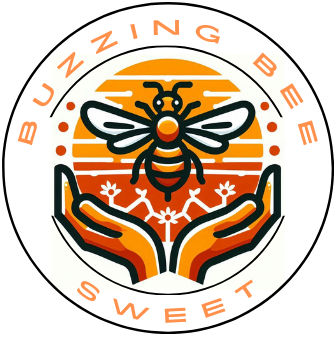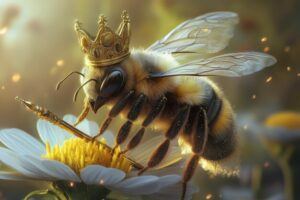
At the heart of every hive rests a Queen Bee, not just royalty in name but a pivotal player whose significance can’t be overstated. This incredible insect is the linchpin holding the complex hive structure together, ensuring everyone knows their role from day one. Think of her as the orchestrator of a buzzing symphony, where each bee has a part to play.
Speaking of types, not all Queen Bees are created equal, and here, diversity shines: you’ve got your virgin queens, newly emerged and ready for their mating flight. Then, there’s the mated Queens, those who’ve returned to rule after a successful and often perilous journey. This distinction is super important and fundamentally shapes the dynamics of the hive.
And here’s a kicker – the Queen Bee doesn’t actually ‘rule’ like a monarch with an iron fist. Instead, her job is to lay eggs. Lots of them. She’s a progenitor, drop-dead vital for the burgeoning of the hive population. We’re talking about thousands of eggs every day during the peak season, which is mind-blowing considering her tiny size.
Now, let’s get into some quick facts that might just blow your mind.
- A Queen Bee’s lifespan dwarfs that of worker bees; she can live up to five years, though productivity usually starts to wane after the first few.
- The Queen Bee emits pheromones, which create a unique chemical profile that keeps the hive calm and coordinated.
- Without a Queen, the hive’s purpose crumbles. Imagine a city losing its mayor overnight with no replacement – chaos would ensue.
- Queen bees don’t sting like workers; they save that business only for dueling other queens.
- Developing Queen larvae are fed a special mixture called royal jelly, which distinguishes them right from the start. So while worker bees munch on a standard diet, future Queens are served gourmet meals.
Understanding these elements provides a solid foundation for appreciating how crucial the Queen Bee is, setting the stage for her many responsibilities and the extraordinary role she plays within the hive’s intricate society.
Physical Distinctions: What Does a Queen Bee Look Like?
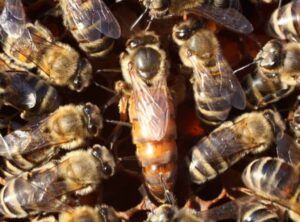
Queen Bee with worker bees (compare the sizes)
Spotting a Queen Bee among the bustling hive feels daunting, much like searching for a needle in a haystack. However, once you learn the key signs, identifying her becomes straightforward and even fascinating.
Queen Bees stand out primarily because of their size; they are usually the largest, with a graceful, elongated abdomen. This abdomen plays a crucial role, enabling them to lay eggs efficiently and support the hive’s reproduction.
In addition to their size, queens have smoother and shinier thoraxes, which allow them to glide through the hive effortlessly. Unlike workers or drones, their bodies are less hairy, further distinguishing them from other bees in the colony.
The queen’s wings also differ significantly. They are shorter in proportion to her body, stopping at her abdomen’s mid-point. This contrasts with other bees, whose wings span their entire body length.
Another identifying feature is her coloration. Although not a strict rule, queens often exhibit more vibrant hues or distinct patterns than other bees. However, since color variation depends on subspecies, observing the hive’s context is essential for accuracy.
Behaviorally, the Queen Bee moves with deliberate purpose, embodying her leadership role. Worker bees, often referred to as her ‘royal court,’ constantly surround her. They feed, groom, and care for her, ensuring she remains in optimal condition for laying eggs.
Her calm demeanor also helps distinguish her. While worker bees dart busily around, the queen moves deliberately, pausing only to lay eggs. These eggs are carefully placed in patterns that sustain the hive’s growth and overall health.
Next time you inspect a hive, look for the large, smooth-bodied, and purposeful bee moving confidently. The Queen Bee’s presence signals the hive’s well-being, reassuring you that everything is as it should be in this industrious world.
Creation of a Monarch: How is a Queen Bee Born?
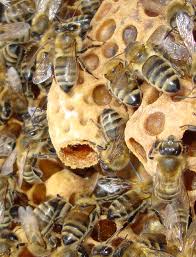
Queen cell is much larger and hangs down vertikal from the cell walls
A Queen Bee’s journey begins long before she earns her crown and title. Worker bees in the hive make a critical decision to choose which freshly laid eggs they will nurture into queens. They don’t make this choice randomly; instead, they act strategically to ensure genetic diversity and the hive’s ongoing prosperity.
After selecting the eggs, worker bees feed the chosen larvae an exclusive diet of royal jelly. This milky, nutrient-rich substance, packed with vitamins and protein, transforms ordinary larvae into Queen material. While all larvae consume royal jelly for the first few days, future Queens continue to eat it until they fully develop.
During development, worker bees place these potential Queen Bees in special ‘queen cups’ or ‘queen cells’ that hang downward, distinctly different from the standard hexagonal cells. This unique architecture provides the space needed for their growth.
After about 16 days—a far quicker process than that of other hive members—the new Queen Bees emerge, ready to face their first major challenge. When multiple Queen Bee larvae develop simultaneously, only one can ultimately take the throne. Upon emerging, a Queen often seeks out her rivals to eliminate competition.
The hive demonstrates its adaptability and resilience by raising new Queen Bees, ensuring that it thrives, not just survives. By observing how worker bees create Queens, we uncover the hive’s intricate, collective decision-making process. This understanding deepens our appreciation for the complex interplay of biology and social structure that sustains hive life.
The Intimate Dance: Mating Behavior of a Honey Bee Queen
The Queen Bee’s mating ritual is a vital chapter of her life, unfolding dramatically in the open expanse of the sky. Shortly after emerging and securing her place, the young Queen embarks on a mating flight. During this flight, the open air becomes her stage, where the hive’s future depends on this extraordinary airborne dance.
During the flight, the Queen mates with multiple drones, often from different hives, ensuring a diverse genetic blend in her offspring. This genetic diversity strengthens the hive, boosting its resilience and protecting it from potential threats in its environment. Although the drones perish in the process, the Queen returns to the hive carrying millions of sperm. This ensures she can lay fertilized eggs continuously for years, supporting the colony’s growth.
Interestingly, Queen Bees only undertake this dangerous yet crucial flight once in their lives. All the sperm she collects is stored in an organ called the spermatheca, which allows her to fertilize eggs throughout her reign. During peak seasons, she can lay thousands of eggs daily, replenishing the hive’s workforce and sustaining its productivity efficiently.
However, timing and conditions play a crucial role in this process. Poor weather can delay the mating flight, affecting the hive’s productivity and future development. Beekeepers closely monitor these conditions to ensure young Queens complete their mating flights on time, safeguarding the hive’s health.
The Queen Bee’s mating ritual combines nature’s precision with elements of chance, reflecting the delicate balance within ecosystems. This remarkable process serves as a vivid reminder of the intricate wonders woven into even the smallest of creatures.
The Central Authority: What is the Queen Bee’s Role in a Hive?
In the hive’s micro-society, the Queen Bee operates as the powerhouse, keeping everything running smoothly from behind the scenes. Her primary duty, beyond ensuring her lineage, stretches to maintaining harmony within the hive through her unique ability to emit pheromones.
These pheromones act like an invisible signal, directing and influencing the behavior of worker bees. Essentially, it’s her way of maintaining order, dictating when bees should forage, nurse young larvae, and even determining the development of more Queens when needed. These chemical messages are thus vital not only for coordination but also in preventing chaos.
When it comes to sheer numbers, the Queen Bee’s egg-laying prowess is unmatched. Her relentless work in laying eggs establishes the hive’s workforce, ensuring there are enough workers to sustain the hive’s operations, from gathering nectar to defending the hive.
The Queen doesn’t directly manage the hive’s tasks like a human monarch would dictate duties. Instead, her presence and pheromones encourage a kind of self-organizing system. Worker bees interpret these signals and know when and how to act, showcasing a remarkable example of decentralized organization that many industries seek to emulate.
Without her steady influence, a hive would quickly falter. Worker bees might try to raise a new Queen, but in her absence, the structure and functionality of the hive could suffer significantly.
In a real sense, the Queen Bee isn’t just a leader by position but the critical heart of hive life, ensuring continuity and coherence. This perspective helps us appreciate the interdependence of all hive members and the balance of nature required for such a complex society to thrive.
Challenges to Monarchy: What Happens When a Queen Bee Dies?
Life in a hive changes dramatically when a Queen Bee dies, setting off a series of urgent events. The first ripple is disorder amongst the workers, followed by the rapid task of nurturing a successor to restore stability. Without the Queen’s pheromonal guidance, the hive enters a kind of limbo, where organization and purpose diminish.
The hive’s immediate survival instincts kick in, with worker bees selecting and preparing larvae to be raised as potential Queens. This process is crucial; a hive’s strength depends on swiftly producing a capable replacement. During this transitional phase, the lack of a Queen Bee can also spur swarming—a natural method of creating a new hive, although it poses risks of weakening the original one.
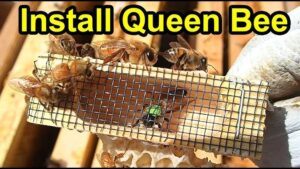
In terms of survival, hives can endure short periods without a Queen Bee, but their long-term prospects dim without swift replacement. This is because the hive’s primary way of maintaining and replenishing its population rests on having a Queen who can produce fertile eggs. In practice, good beekeepers monitor the situation closely, prepared to step in. Either by introducing a new queen or facilitating the natural queen-rearing process to ensure continuity.
Understanding what happens when a Queen Bee dies helps realize the delicate balance within the hive. Every bee, from workers to potential new Queens, plays a role in safeguarding their community. Showcasing a level of cooperation and urgency inspired by the Queen Bee’s absence. Their adaptability is a testament to nature’s resilience, illustrating the collective effort required to sustain their buzzing society.
This post may contain affiliate links.
